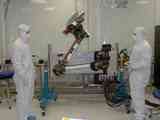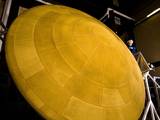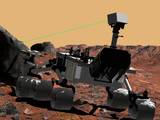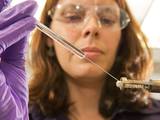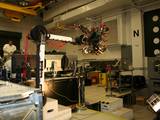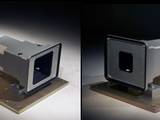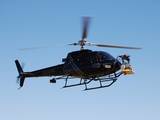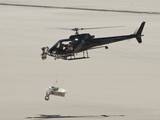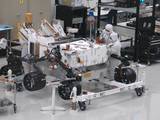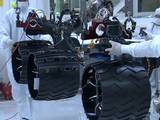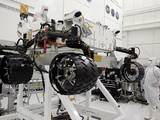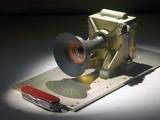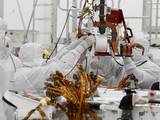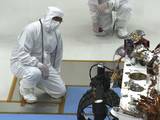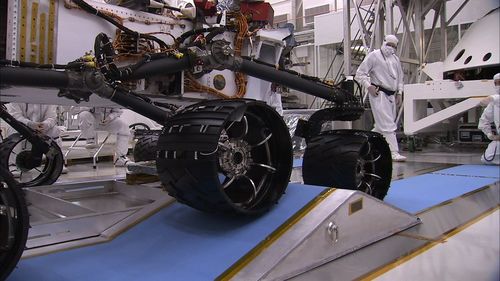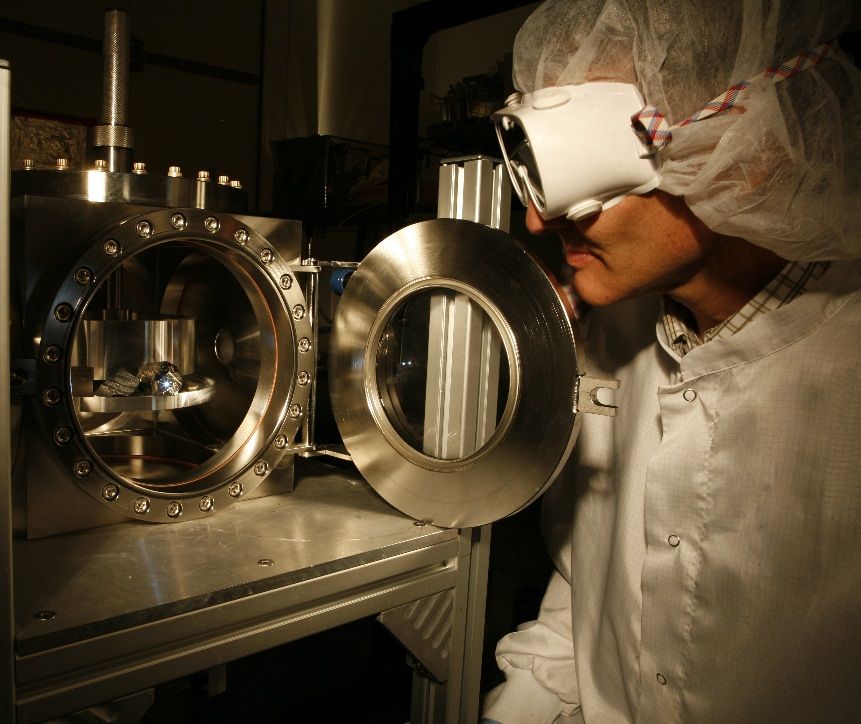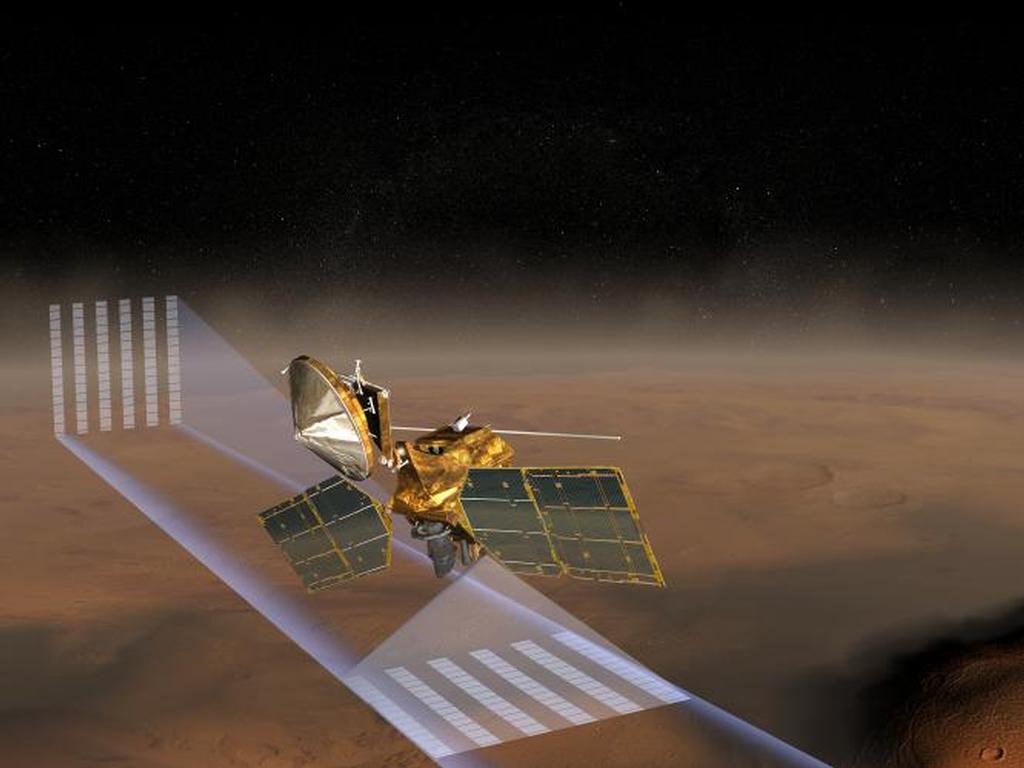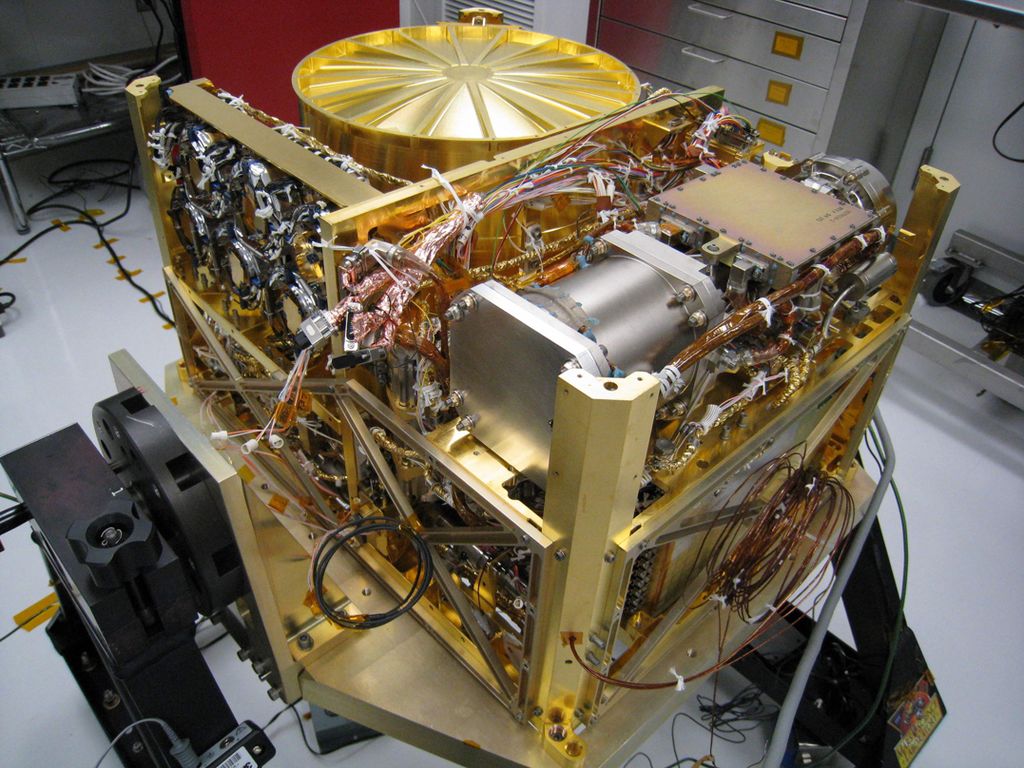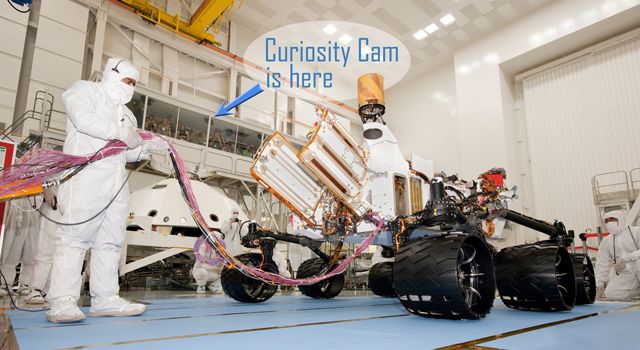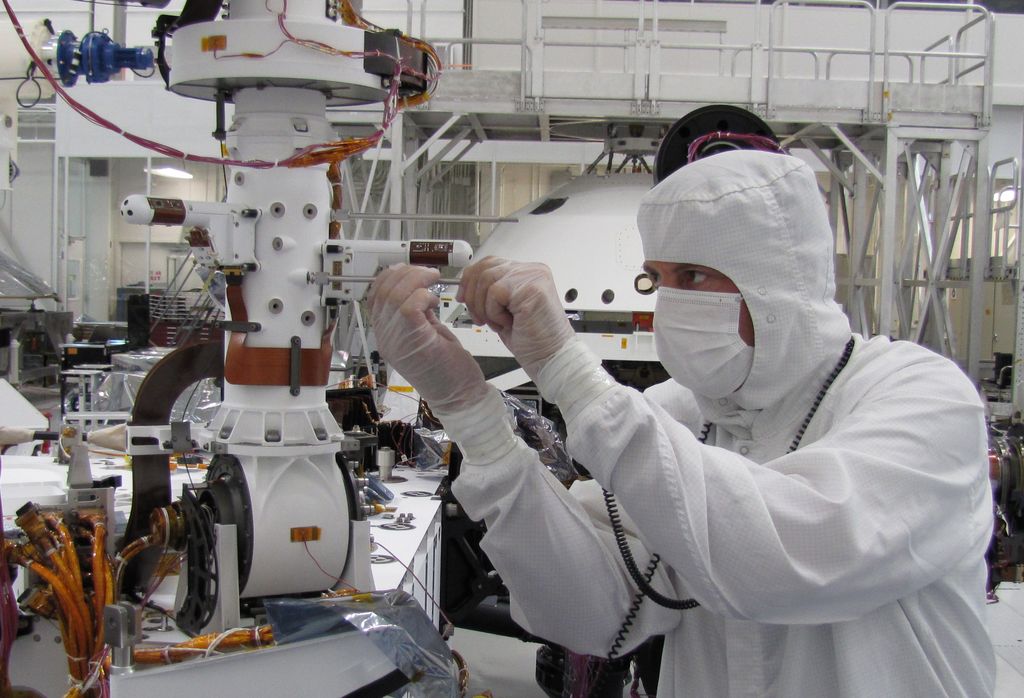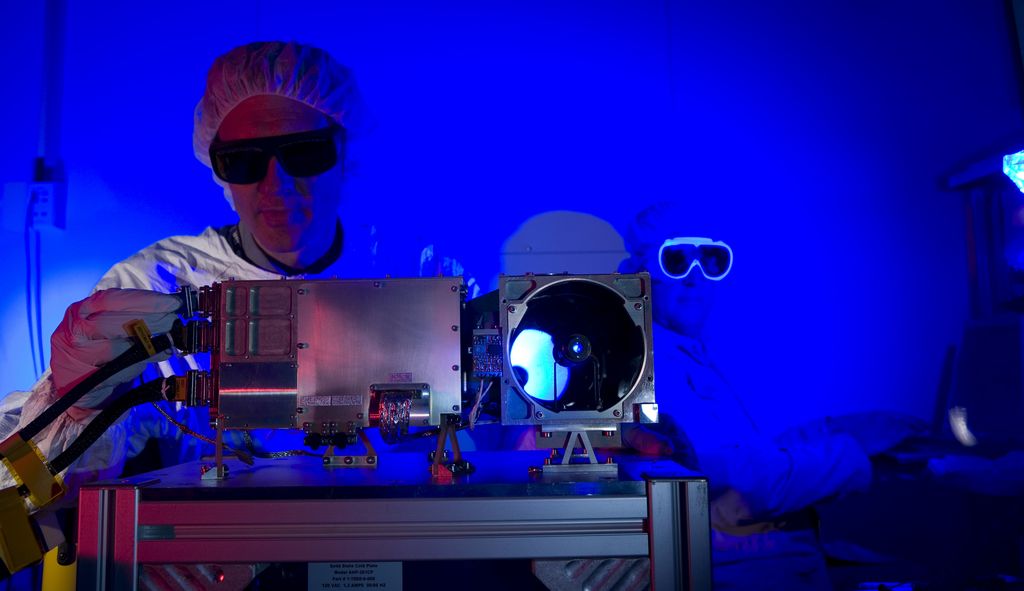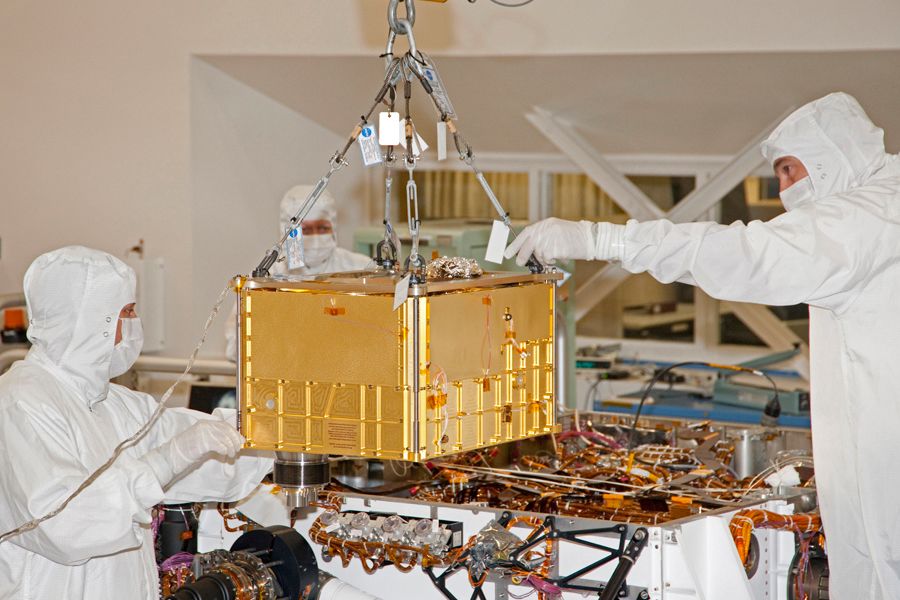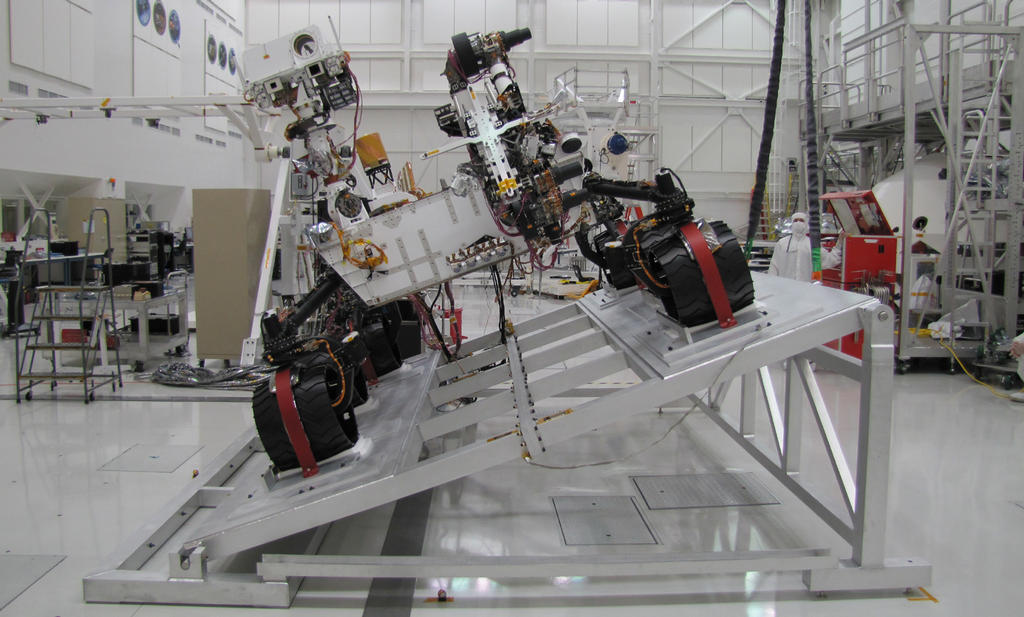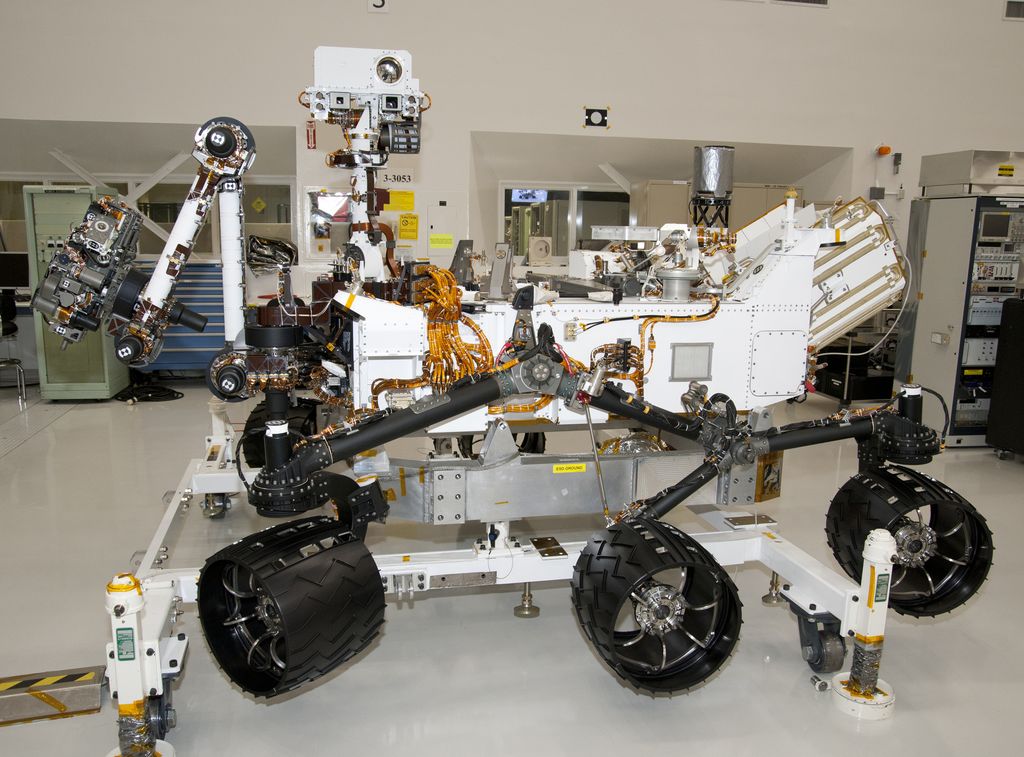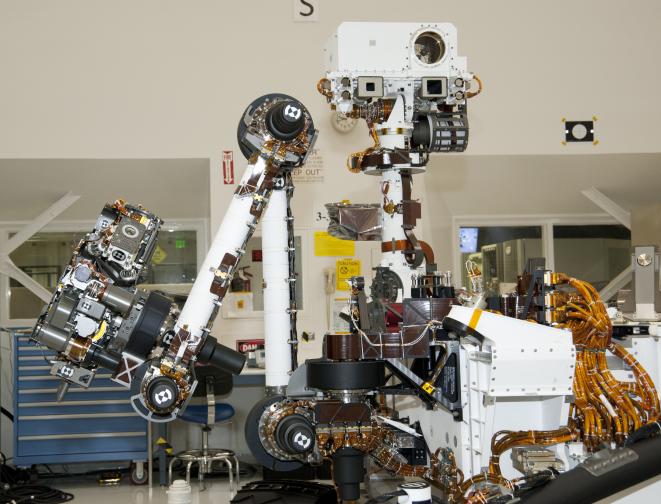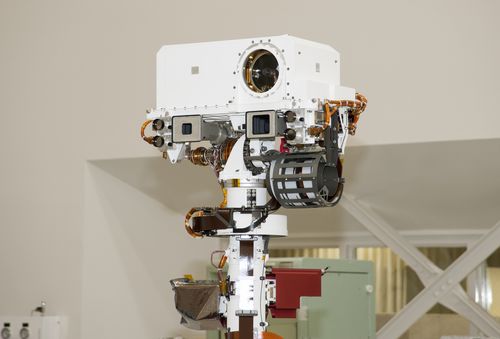Curiosity: Mars Science Laboratory
Curiosity: Mars Science Laboratory
In the 2008/11/24 APOD (Glaciers on Mars), there is a link (http://marsprogram.jpl.nasa.gov/msl/) to suggesting a name for the next Mars rover. In looking over the included pictures, I noticed that the mated image (http://marsprogram.jpl.nasa.gov/msl/spo ... 1119_3.gif) looks like the Jupiter II from "Lost in Space." Given the history of NASA probes over the last few years, this seems unusually foreshadowing in nature. Am I the only one that noticed this?
Re: Naming the New Mars Rover
http://www.cloudster.com/sets&vehicles/ ... iterII.htmben_3 wrote:looks like the Jupiter II from "Lost in Space."
- neufer
- Vacationer at Tralfamadore
- Posts: 18805
- Joined: Mon Jan 21, 2008 1:57 pm
- Location: Alexandria, Virginia
Re: Naming the New Mars Rover
But that won't take place until 1997: <<In the year 1997, Earth is suffering from massive overpopulation. Professor John Robinson, his wife Maureen, their children (Judy, Penny and Will) and Major Don West are selected to go to the third planet in the Alpha Centauri star system to establish a colony so that other Earth people can settle there. They are to go there on a ship of Professor Robinson's design, christened the Jupiter 2. However, Doctor Zachary Smith, an agent for an enemy government, is sent to sabotage the mission. He is successful in reprogramming the ship's robot, but in the process becomes trapped on the ship, and because of his excess weight, the ship and all on board become hopelessly lost and it now becomes a fight for survival as the crew tries to find their way back home.>>bystander wrote:http://www.cloudster.com/sets&vehicles/ ... iterII.htmben_3 wrote:looks like the Jupiter II from "Lost in Space."
"Lost in Space" (1965) http://www.imdb.com/title/tt0058824/
http://www.youtube.com/watch?v=MfukvixjzYU
http://www.youtube.com/watch?v=OepIWKoX3DM
http://www.hulu.com/watch/12429/space-circus
Art Neuendorffer
MSL Postponed to 2011
Next NASA Mars Mission Rescheduled for 2011
NASA PR 08-319 - 2008 Dec 04
NASA's Mars Science Laboratory will launch two years later than previously planned, in the fall of 2011. The mission will send a next-generation rover with unprecedented research tools to study the early environmental history of Mars.
A launch date of October 2009 no longer is feasible because of testing and hardware challenges that must be addressed to ensure mission success. The window for a 2009 launch ends in late October. The relative positions of Earth and Mars are favorable for flights to Mars only a few weeks every two years. The next launch opportunity after 2009 is in 2011.
NASA Mission News - MSL - 2008 Dec 04
NASA PR 08-319 - 2008 Dec 04
NASA's Mars Science Laboratory will launch two years later than previously planned, in the fall of 2011. The mission will send a next-generation rover with unprecedented research tools to study the early environmental history of Mars.
A launch date of October 2009 no longer is feasible because of testing and hardware challenges that must be addressed to ensure mission success. The window for a 2009 launch ends in late October. The relative positions of Earth and Mars are favorable for flights to Mars only a few weeks every two years. The next launch opportunity after 2009 is in 2011.
NASA Mission News - MSL - 2008 Dec 04
Re: Naming the New Mars Rover
caugh.. With the economic situation right now we might have to name it "Bailout" 


Wired: New Lasers Fight Crime, Martians
New Lasers Fight Crime, Martians
Wired Science | February 16, 2010
Wired Science | February 16, 2010
A new technique that uses a laser to vaporize materials like rocks and steel to analyze their chemical composition is finding new applications from Mars to forensics.
Thanks to its relatively small size and low cost, laser-induced breakdown spectroscopy (LIBS) is emerging from the laboratory and turning into a precise tool for figuring out what something is made of. What had been a technique largely for scientists now can be transformed into a tough, small system that can be operated by a technician instead of a PhD.
...
NASA will be deploying a LIBS system called the “ChemCam” on its new Mars rover, now named Curiosity and scheduled to launch next year.
LIBS works by blasting a material with a high-energy laser pulses. The Mars Curiosity rover will send an average of three pulses a second, each one 5 nanoseconds long. The power during that pulse is in the range of 10 megawatts.
...
There are no plans to use the laser for anything but science, but there’s something science-fictionally satisfying about the next Mars rover coming equipped with a laser “gun.”
Curiosity: Mars Science Laboratory
Curiosity: Mars Science Laboratory
As we approach the late 2011 launch date for Curiosity, the Mars Science Laboratory (MSL), news begins to accumulate on its assembly and testing. I thought I would hijack this old thread as a repository for MSL news.
MSL Home Page
MSL Fact Sheets
MSL News Releases
MSL Mission Pages
First, old news from 2009
NASA Selects Student's Entry as New Mars Rover Name
NASA JPL MSL | 14 April 2010
NASA JPL MSL | 12 June 2009
NASA JPL MSL | Lockheed Martin | 10 July 2009
NASA JPL MSL | NASA Science News | 30 Oct 2009
As we approach the late 2011 launch date for Curiosity, the Mars Science Laboratory (MSL), news begins to accumulate on its assembly and testing. I thought I would hijack this old thread as a repository for MSL news.
MSL Home Page
MSL Fact Sheets
MSL News Releases
MSL Mission Pages
First, old news from 2009
NASA Selects Student's Entry as New Mars Rover Name
Mars Science Laboratory Parachute Qualification TestingNASA's Mars Science Laboratory rover, scheduled for launch in 2011, has a new name, thanks to a sixth-grade student from Kansas. Twelve-year-old Clara Ma from the Sunflower Elementary school in Lenexa submitted the winning entry, "Curiosity." As her prize, Ma wins a trip to NASA's Jet Propulsion Laboratory in Pasadena, Calif., where she will be invited to sign her name directly onto the rover as it is being assembled.
A NASA panel selected the name following a nationwide student contest that attracted more than 9,000 proposals via the Internet and mail. The panel primarily took into account the quality of submitted essays. Name suggestions from the Mars Science Laboratory project leaders and a non-binding public poll also were considered.
Winning Student Essay
'Curiosity,' Meet Clara
NASA JPL MSL | 14 April 2010
The Rover Gets Strong-ArmedThe parachute for NASA's Mars Science Laboratory passed flight-qualification testing in March and April 2009 inside the world's largest wind tunnel, at NASA Ames Research Center, Moffett Field, Calif.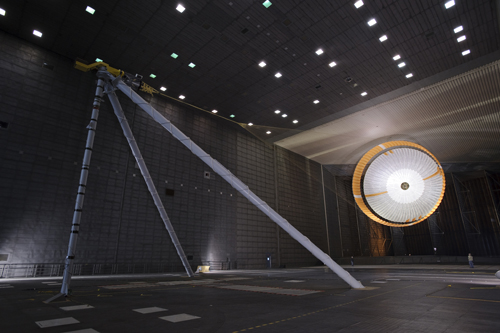
In this image, an engineer is dwarfed by the parachute, the largest ever built to fly on an extraterrestrial flight. It is designed to survive deployment at Mach 2.2 in the Martian atmosphere, where it will generate up to 65,000 pounds of drag force.
The parachute, built by Pioneer Aerospace, South Windsor, Conn., uses a configuration called disk-gap-band. It has 80 suspension lines, measures more than 50 meters (165 feet) in length, and opens to a diameter of nearly 16 meters (51 feet). Most of the orange and white fabric is nylon, though a small disk of heavier polyester is used near the vent in the apex of the canopy due to higher stresses there.
The wind tunnel is 24 meters (80 feet) tall and 37 meters (120 feet) wide, big enough to house a Boeing 737. It is part of the National Full-Scale Aerodynamics Complex, operated by the U.S. Air Force, Arnold Engineering Development Center.
NASA's Jet Propulsion Laboratory, Pasadena, Calif., is building and testing the Mars Science Laboratory spacecraft for launch in 2011. The mission will land a roving analytical laboratory on the surface of Mars in 2012.
More Images
NASA JPL MSL | 12 June 2009
Heat Shield Readied for Next Mars RoverThe Mars Science Laboratory rover will sport the biggest, toughest robotic arm the red planet's ever seen! This super-limb must lift 34 kilograms (almost 75 pounds) of instruments to reach out and test martian rocks and soil, which may hold clues about whether Mars could have supported life. Longer than most people are tall, the arm also provides heavy-duty support for the sampling drill. The drill requires a lot of "muscle" to hold it still on the rock. But, the arm isn't all brawn - it must delicately deposit the precious drill samples inside the rover for further testing.
So, how does the rover train to do all this heavy-lifting? Team members build two identical arms. They just completed the one that will stay here on Earth. They will use it for practice, in preparation for the one that will go to Mars on the rover. One strong arm down, and one to go!
NASA JPL MSL | Lockheed Martin | 10 July 2009
A Mars Rover Named "Curiosity"Lockheed Martin [NYSE: LMT] has completed production and testing of the heatshield for NASA’s Mars Science Laboratory (MSL). The heatshield is half of the large and sophisticated two-part aeroshell that will encapsulate and protect the Curiosity rover during its deep space cruise to Mars, and from the intense heat and friction that will be generated as the system descends through the Martian atmosphere.
...
The aeroshell/heatshield is the largest ever built to be flown at 4.5 meters (nearly 15 feet) in diameter. In contrast, the aeroshells/heatshields of the Spirit and Opportunity Mars Exploration Rovers measured 8.5 feet and Apollo capsule heatshields measured just less than 13 feet.
Because of the unique entry trajectory profile that could create external temperatures up to 3,800 degrees Fahrenheit, the heatshield uses a tiled Phenolic Impregnated Carbon Ablator (PICA) thermal protection system instead of the Mars heritage Super Lightweight Ablator (SLA) 561V. This will be the first time PICA has flown on a Mars mission. Invented by NASA Ames Research Center, PICA was first flown as the thermal protection system on the heatshield of the Stardust Sample Return Capsule that is now in the Smithsonian Air and Space Museum.
...
The aeroshell has a steering capability that is produced by ejecting ballast that off-sets the center-of-mass prior to entry into the atmosphere. This off-set creates lift as it interacts with the thin Martian atmosphere and allows roll control and autonomous steering through the use of thrusters.
NASA JPL MSL | NASA Science News | 30 Oct 2009
If you found your grandmother's diary, tattered and dust covered, up in the attic, would you read it? Of course you would. Granny was a pistol! Brush off the dust, open up the little book, and foray into her lively and interesting past.
Dust cloaks some fascinating tales in other places, too. NASA scientists will soon brush the dust off some Martian rocks that are practically bursting their seams to give their lively account of the red planet's past. The Mars Science Lab -- aptly named "Curiosity" -- is heading up there in 2011 to read the diary of Mars.
The small, car-sized rover will ramble about on the rocky surface, gizmos at full tilt, not only brushing dust off rocks but also vaporizing them with a laser beam, gathering samples to analyze on the spot, taking high resolution photographs, and more.
Curiosity: Mars Science Laboratory
Goddard Scientist's Breakthrough Given Ticket to Mars
NASA JPL MSL | GSFC | 06 Jan 2010
NASA JPL MSL | 11 Feb 2010
NASA JPL MSL | 06 Apr 2010
NASA JPL MSL | 13 Apr 2010
NASA JPL MSL | 20 May 2010
NASA JPL MSL | 11 June 2010
NASA JPL MSL | 28 June 2010
NASA JPL MSL | 01 July 2010
NASA JPL MSL | 07 July 2010
NASA JPL MSL | 13 July 2010
NASA JPL MSL | 18 July 2010
NASA JPL MSL 23 July 2010
NASA JPL MSL 23 July 2010
NASA JPL MSL | GSFC | 06 Jan 2010
Engineers Flex Curiosity's Robotic Arm and ToolsThe quest to discover whether Mars ever hosted an environment friendly to microscopic forms of life has just gotten a shot in the arm.
An experiment proposed by Jennifer Eigenbrode has been added to the Sample Analysis at Mars (SAM) instrument on a mobile NASA laboratory that will land on Mars in 2012. Goddard scientists developed SAM. The newly added experiment will enhance SAM's ability to analyze large carbon molecules if the mission is fortunate enough to find any.
The mission, NASA's Mars Science Laboratory, will be checking whether a carefully chosen area of Mars has ever had an environment favorable for the development of life and preservation of evidence about life. The mission's car-sized rover will analyze dozens of samples scooped from soil and drilled from rocks.
None of the rover's 10 instruments is designed to identify past or present life, but SAM has a key role of checking for carbon-containing compounds that potentially can be ingredients or markers of life. Most environments on Mars may not have enabled preservation of these compounds, which are called organic molecules, but if any did, that could be evidence of conditions favorable for life.
Eigenbrode secured the flight opportunity for her experiment after successfully proving in a series of tests earlier this year that the combination of heat and a specific chemical would significantly enhance SAM's ability to analyze large carbon molecules.
NASA JPL MSL | 11 Feb 2010
San Diego Team Delivers Camera for Next Mars RoverEngineers just completed the first end-to-end test for Curiosity's robotic arm and sampling tools, "flexing" the arm to see if it plays "nice" with the rest of the system.
Engineers exercised this test arm, which is identical to the robotic arm that will actually be attached to Curiosity. The real arm is being built in cleanrooms, and will be attached to Curiosity later in the year.
In a few months, engineers will begin the next phase of fitness testing: drilling rocks and practicing using the arm as if the rover were on Mars.
NASA JPL MSL | 06 Apr 2010
Helicopter Helps Test Radar for 2012 Mars LandingMalin Space Science Systems Inc., San Diego, has delivered the two cameras for the Mast Camera instrument that will be the science-imaging workhorse of NASA's Mars Science Laboratory rover, to be launched next year. The instrument, called Mastcam, has been tested and is ready for installation onto the rover, named Curiosity, which is being built at NASA's Jet Propulsion Laboratory, Pasadena, Calif.
The two component cameras have different fixed focal lengths: 34 millimeters and 100 millimeters (telephoto) and can provide high-definition color video. NASA is also providing funds for Malin to build an alternative version with zoom lenses on both cameras, in collaboration with movie producer James Cameron, a member of the Mastcam team. If the zoom pair can be completed in time for rover assembly and testing, the fixed-focal-length pair could be swapped out for them. Malin has also delivered the Mars Hand Lens Imager and the Mars Descent Imager for the Mars Science Laboratory. For more information, see Malin Space Science Systems news release.
NASA JPL MSL | 13 Apr 2010
Geometry Drives Selection Date For 2011 Mars LaunchThis spring, engineers are testing a radar system that will serve during the next landing on Mars.
Recent tests included some near Lancaster, Calif., against a backdrop of blooming California poppy fields. In those tests, a helicopter carried an engineering test model of the landing radar for NASA's Mars Science Laboratory on prescribed descent paths. The descents at different angles and from different heights simulated paths associated with specific candidate sites for the mission.
During the final stage of the spacecraft's arrival at Mars in 2012, a rocket-powered descent stage will lower the rover on a tether directly to the ground. This rover is too big for the airbag-cushioned landing method used by NASA's Mars Pathfinder mission in 1997 and Mars Exploration Rover landings in 2004.
At Mars, a radar on the descent stage will track the spacecraft’s decreasing distance from the surface. Additional helicopter-flown testing of the mission's radar system will include checks of whether the suspended rover might confuse the radar about the speed of descent toward the ground.
Wolfe Air Aviation, of Pasadena, Calif., is providing the helicopter and flight services for the testing by a team of JPL engineers. The engineering test radar is affixed to a gimbal mounting at the front of the helicopter, which is more often used for aerial photography.
NASA JPL MSL | 20 May 2010
NASA Dryden Hosts Radar Tests for Next Mars LandingPlanners of NASA's next Mars mission have selected a flight schedule that will use favorable positions for two currently orbiting NASA Mars orbiters to obtain maximum information during descent and landing.
Continuing analysis of the geometry and communications options for the arrival at Mars have led planners for the Mars Science Laboratory, or Curiosity, to choose an Earth-to-Mars trajectory that schedules launch between Nov. 25 and Dec. 18, 2011. Landing will take place between Aug. 6 and Aug. 20, 2012. Due to an Earth-Mars planetary alignment, this launch period actually allows for a Mars arrival in the earlier portion of the landing dates under consideration.
"The key factor was a choice between different strategies for sending communications during the critical moments before and during touchdown," said Michael Watkins, mission manager at NASA's Jet Propulsion Laboratory in Pasadena, Calif. "The shorter trajectory is optimal for keeping both orbiters in view of Curiosity all the way to touchdown on the surface of Mars. The longer trajectory allows direct communication to Earth all the way to touchdown."
The simplicity of direct-to-Earth communication from Curiosity during landing has appeal to mission planners, in comparison to relying on communications relayed via NASA's Mars Odyssey, which has been orbiting Mars since 2001, and NASA's Mars Reconnaissance Orbiter, in operation since 2006. However, the direct-to-Earth option allows a communication rate equivalent to only about 1 bit per second, while the relay option allows about 8,000 bits or more per second.
Landing on Mars is always difficult, with success uncertain. After an unsuccessful attempted Mars landing in 1999 without definitive information on the cause of the mishap, NASA put a high priority on communication during subsequent Mars landings.
NASA JPL MSL | 11 June 2010
NASA Instrument (CheMin) Will Identify Clues to Martian PastEngineers with NASA's Jet Propulsion Laboratory, Pasadena, Calif., are running diverse trials with a test version of the radar system that will enable NASA's Mars Science Laboratory mission to put the Curiosity rover onto the Martian surface in August 2012.
One set of tests conducted over a desert lakebed at NASA's Dryden Flight Research Center, Edwards, Calif., in May 2010 used flights with a helicopter simulating specific descent paths anticipated for Martian sites.
During the final stage of descent, NASA's Mars Science Laboratory mission will use a "sky crane" maneuver to lower Curiosity on a bridle from the mission's rocket-powered descent stage. The descent stage will carry Curiosity's flight radar.
The testing at Dryden included lowering a rover mockup on a tether from the helicopter to assess how the sky crane maneuver will affect the radar's descent-speed determinations by the radar. The helicopter carried the test radar on a special nose-mounted gimbal.
Helicopter-flown testing has also been conducted at other desert locations for experience in an assortment of terrains. Later in 2010, the team plans to test the higher-altitude, higher-velocity part of Curiosity's radar-aided descent by flying the test radar on dives by an F/A-18 jet from Dryden.
NASA JPL MSL | 28 June 2010
Next Mars Rover Sports a Set of New WheelsNASA's Curiosity rover, coming together for a late 2011 launch to Mars, has a newly installed component: a key onboard X-ray instrument for helping the mission achieve its goals.
Researchers will use Curiosity in an intriguing area of Mars to search for modern or ancient habitable environments, including any that may have also been favorable for preserving clues about life and environment.
The team assembling and testing Curiosity at NASA's Jet Propulsion Laboratory, Pasadena, Calif., fastened the Chemistry and Mineralogy (CheMin) instrument inside the rover body on June 15. CheMin will identify the minerals in samples of powdered rock or soil that the rover's robotic arm will deliver to an input funnel.
"Minerals give us a record of what the environment was like at the time they were formed," said the principal investigator for CheMin, David Blake of NASA's Ames Research Center, Moffett Field, Calif. Temperature, pressure, and the chemical ingredients present -- including water -- determine what minerals form and how they are altered.
The instrument uses X-ray diffraction, a first for a mission to Mars and a more definitive method for identifying minerals than any instrument on previous missions. It supplements the diffraction measurements with X-ray fluorescence capability to garner further details of composition.
NASA JPL MSL | 01 July 2010
We’ve Got Wheels!NASA's next Mars rover, Curiosity, is sitting pretty on a set of spiffy new wheels that would be the envy of any car show on Earth.
The wheels and a suspension system were added this week by spacecraft technicians and engineers. These new and important touches are a key step in assembling and testing the flight system in advance of a planned 2011 launch.
Curiosity, centerpiece of NASA's Mars Science Laboratory mission, is a six-wheeler and uses a rocker-bogie suspension system like its smaller predecessors: Spirit, Opportunity and Sojourner. Each wheel has its own drive motor, and the corner wheels also have independent steering motors. Unlike earlier Mars rovers, Curiosity will also use its mobility system as a landing gear when the mission's rocket-powered descent stage lowers the rover directly onto the Martian surface on a tether in August 2012.
In coming months at NASA's Jet Propulsion Laboratory, the mobility system will get functional testing and be part of environmental testing of the rover. The mobility system will now stay on Curiosity through launch unless testing identifies a need for rework that would require it to be disassembled.
NASA JPL MSL | 07 July 2010
Curiosity Spins Its WheelsSix of them! And these wheels aren’t meant for the concrete roadways, bustling freeways, or sleepy highways - they’re destined for off-roading on Mars.
The Curiosity rover team just installed six shiny aluminum wheels on the rover, giving the rover its “legs.” Unlike previous missions that used air bags for landing on the Martian surface, Curiosity is touching down wheels first!
The rover, which is about the size of an SUV, has wheels that are 50 centimeters (20 inches) in diameter, making them bigger than a car tire. Each wheel has its own motor, giving the rover independent six-wheel drive - that’s better than an average car with two-wheel drive. But engineers didn’t stop there; the rover can swerve and turn in place a full 360 degrees.
Now, that’s cool but you may be wondering, how’s the ride? The suspension system is based on the “rocker-bogie” system, which was used on the Spirit and Opportunity rovers and the earlier Pathfinder missions. This system allows the rover to roll over large rocks and dips without tipping over. The rover can also climb steep hills, up to 45 degrees.
Did you know that the rover has something in common with World Cup soccer players? Yes, the rover wheels have “cleats,” similar to those soccer players have on their shoes. These cleats provide grip and prevent the rover from slipping while going over rocks or climbing up hills of soft sand.
With the wheels in place, Curiosity is one step closer to rolling on Mars.
Follow its journey as it embarks on one of the most exciting expeditions of our time.
NASA JPL MSL | 13 July 2010
Video Camera Will Show Mars Rover's TouchdownThe wheels that will touch down on Mars in 2012 are several rotations closer to spinning on the rocky trails of Mars.
Engineers raised the rover just as a car mechanic would hoist a car to check the wheels, and started the “engine” to get the wheels rotating. The wheel mobility system has 10 motors in all—four for steering the rover and six for driving. During this test, all 10 motors ran in every direction. Each wheel spun forward and backwards.
Next up for Curiosity is a series of “tune-ups” to prep the rover for driving.
NASA JPL MSL | 18 July 2010
Curiosity Rover Grows by Leaps and BoundsA downward-pointing camera on the front-left side of NASA's Curiosity rover will give adventure fans worldwide an unprecedented sense of riding a spacecraft to a landing on Mars.
The Mars Descent Imager, or MARDI, will start recording high-resolution video about two minutes before landing in August 2012. Initial frames will glimpse the heat shield falling away from beneath the rover, revealing a swath of Martian terrain below illuminated in afternoon sunlight. The first scenes will cover ground several kilometers (a few miles) across. Successive images will close in and cover a smaller area each second.
The full-color video will likely spin, then shake, as the Mars Science Laboratory mission's parachute, then its rocket-powered backpack, slow the rover's descent. The left-front wheel will pop into view when Curiosity extends its mobility and landing gear.
The spacecraft's own shadow, unnoticeable at first, will grow in size and slide westward across the ground. The shadow and rover will meet at a place that, in the final moments, becomes the only patch of ground visible, about the size of a bath towel and underneath the rover.
Dust kicked up by the rocket engines during landing may swirl as the video ends and Curiosity's surface mission can begin.
All of this, recorded at about four frames per second and close to 1,600 by 1,200 pixels per frame, will be stored safely into the Mars Descent Imager's own flash memory during the landing. But the camera's principal investigator, Michael Malin of Malin Space Science Systems, San Diego, and everyone else will need to be patient. Curiosity will be about 250 million kilometers (about 150 million miles) from Earth at that point. It will send images and other data to Earth via relay by one or two Mars orbiters, so the daily data volume will be limited by the amount of time the orbiters are overhead each day.
NASA JPL MSL 23 July 2010
Mars Curiosity Takes First Baby StepsTalk about a growth-spurt. In one week, Curiosity grew by approximately 1 meter (3.5 feet) when spacecraft technicians and engineers attached the rover’s neck and head (called the Remote Sensing Mast) to its body. At around 2 meters (about 7 feet) tall, the next rover to Mars now stands head and shoulders above the rest.
Mounted on Curiosity’s mast are two navigation cameras (Navcams), two mast cameras (Mastcam), and the laser-carrying chemistry camera (ChemCam).
While it now has a good head on its shoulders, Curiosity’s “eyes” (the Mastcam), have been blindfolded in a protective silvery material. The Mastcam, containing two digital cameras, will soon be unveiled, so engineers can test its picture-taking abilities.
NASA JPL MSL 23 July 2010
Like proud parents savoring their baby’s very first steps, mission team members gathered in a gallery above a clean room at NASA’s Jet Propulsion Laboratory to watch the Mars Curiosity rover roll for the first time.
Engineers and technicians wore “bunny suits” while guiding Curiosity through its first steps, or more precisely, its first roll on the clean room floor. The rover moved forward and backward about 1 meter (3.3 feet).
Mars Science Laboratory (aka Curiosity) is scheduled to launch in fall 2011 and land on the Red Planet in August 2012. Curiosity is the largest rover ever sent to Mars. It will carry 10 instruments that will help search an intriguing region of the Red Planet for two things:
- Environments where life might have existed
- The capacity of those environments to preserve evidence of past life
Re: Curiosity: Mars Science Laboratory
Four finalist landing site candidates for Mars Science Laboratory | 19 Nov 2008
Out of more than 30 sites considered as possible landing targets for NASA's Mars Science Laboratory mission, by November 2008 four of the most intriguing places on Mars rose to the final round of the site-selection process.
The four finalists are, alphabetically:The locations of these four candidates are indicated here on a background map of color-coded topographical data from the Mars Orbiter Laser Altimeter on NASA's Mars Global Surveyor. Red is higher elevation; blue is lower elevation. In latitude, the map extends from 70 degrees (north) to minus 70 degrees (south). The east-west axis is labeled at the top in degrees of east longitude, with the zero meridian at the center.
- Eberswalde, where an ancient river deposited a delta in a possible lake;
- Gale, with a mountain of stacked layers including clays and sulfates;
- Holden, a crater containing alluvial fans, flood deposits, possible lake beds and clay-rich deposits; and
- Mawrth, which shows exposed layers containing at least two types of clay.
The Mars Science Laboratory mission's capabilities for landing more precisely and at higher elevation than ever before, for driving farther, and for generating electricity without reliance on sunshine have enabled consideration of a wider range of possible landing sites than for any previous Mars mission. During the past two years, multiple observations of dozens of candidate sites by NASA's Mars Reconnaissance Orbiter have augmented data from earlier orbiters for evaluating sites' scientific attractions and engineering risks.
More than 100 Mars scientists have participated in a series of open workshops presenting and assessing data that the orbiters have provided about the candidate sites. The four sites rated highest by researchers at a September 2008 workshop were the same ones chosen by mission leaders after a subsequent round of safety evaluations and analysis of terrain for rover driving. As a clay-bearing site where a river once flowed into a lake, Eberswalde Crater offers a chance to use knowledge that oil industry geologists have accumulated about locations of the most promising parts of a delta to look for any concentrations of carbon chemistry that is crucial to life.
Eberswalde Crater offers the chance to explore an ancient river delta. In fact, the delta is the most convincing sign that a Martian river once flowed into a standing body of water. Stream channels in the delta have meandered over time. As the streams carved new channels, abandoned streambeds remained behind as "footprints." Today, many of these streambeds are higher than the surrounding terrain. That's because the water deposited sediments that hardened and became resistant to erosion. Orbiters above Mars have detected clay minerals in the sediments. Clays are evidence of past water activity for the Mars Science Laboratory to investigate. Clays form when water dissolves rocks into extremely fine-grained minerals. These minerals form layers, kind of like the parts of a sandwich. The mountain inside Gale Crater could provide a route for the rover to drive up a 5-kilometer (3-mile) sequence of layers, studying a transition from environments that produced clay deposits near the bottom to later environments that produced sulfate deposits partway up.
Gale Crater is a fascinating place to explore because of the mountain of layered materials in the middle. On Earth, this mound would be a mountain 5 kilometers (3 miles) high! The layers tell a story about what Mars was like in the past, perhaps spanning much of the history of the red planet. Studies from orbit have revealed that the layers have different minerals depending on their height. Near the bottom of the mound are clay minerals. Above the clay-bearing layers are layers with sulfur and oxygen-bearing minerals are above them. Flowing water appears to have carved channels in both the mound and the crater wall. To get to the mound, the Mars Science Laboratory would land in a flatter part of the crater and carefully work its way upward, layer by layer. Along the way, the rover would investigate how the layers formed and the environments in which they formed. Running water once carved gullies and deposited sediments as alluvial fans and catastrophic flood deposits in Holden Crater, a site that may also present the chance to evaluate layers deposited in a lake. Exploration of key features within this target area would require drives to the edge of a broad valley, and then down into the valley.
Holden Crater sits within a string of craters that look like a chain of alpine lakes connected by a stream. The crater offers tantalizing clues to the history of water on Mars. Running water carved deep gullies in the crater. Water also carried sediments onto the floor of a prospective lakebed. These deposits are more than 3 billion years old, dating back to a wetter period of early martian history. Geological studies suggest that a massive, catastrophic flood may have breached part of the crater rim that was holding back water. The water eventually disappeared. Later, wind eroded the surface and exposed ancient sediments. Winds also formed ripples and dunes that are still visible on the surface today. Holden Crater offers the opportunity to examine some of the most ancient rocks on Mars. Another benefit of the site is that the mission would not have to drive far to get there. The rover would land on top of a "bajada," a high plateau of material eroded from nearby cliffs. Mawrth Vallis is an apparent flood channel near the edge of vast Martian highlands. It holds different types of clays in clearly layered context, offering an opportunity for studying the changes in wet conditions that produced or altered the clays. The clay signatures are stronger than at the other sites, and this is the only one of the four for which the science target is within the landing area, not nearby.
Mawrth Vallis is smack in the middle of a region that has always been mysterious to scientists. This region is the boundary between the southern highlands and northern lowlands of Mars. It is a place where the entire planet suddenly drops in elevation. In effect, Mars is lopsided. Its southern hemisphere is higher in elevation than its northern hemisphere. Mawrth Vallis itself is an ancient channel carved by catastrophic floods. "Mawrth" is the Welsh word for Mars and "Vallis" is Latin for valley. Layered cliffs, which look like Neapolitan ice cream, are rich in clay minerals. Such minerals, called phyllosilicates, form in the presence of water. They may yield information about past environments that could have supported life. Mawrth Vallis is also conveniently near a hazard-free landing zone. The Mars Science Laboratory science team would use the rover to piece together the history of this puzzling site and look for conditions favorable to life. Credit: NASA/JPL/Caltech/ASU
Landing Site Selection
Curiosity: Mars Science Laboratory
Next Mars Rover Stretches Robotic Arm
NASA JPL MSL | 2010-288 | 03 Sept 2010
NASA JPL MSL | 2010-297 | 13 Sept 2010
NASA JPL MSL | 2010-288 | 03 Sept 2010
NASA's Next Mars Rover Rolls Over RampsCuriosity, the Mars Science Laboratory rover that will be on Mars two years from now, has been flexing the robotic arm that spacecraft workers at NASA's Jet Propulsion Laboratory attached to the rover body in August 2010.
The arm will be crucial for putting samples of soil or powdered rock into analytical instruments inside the rover. A camera and spectrometer to be installed at the end of the arm will also examine rocks and soils in place.
Credit: NASA/JPL-Caltech - Video
NASA JPL MSL | 2010-297 | 13 Sept 2010
The rover Curiosity, which NASA's Mars Science Laboratory mission will place on Mars in August 2012, has been rolling over ramps in a clean room at NASA's Jet Propulsion Laboratory to test its mobility system.
Curiosity uses the same type of six-wheel, rocker-bogie suspension system as previous Mars rovers, for handling uneven terrain during drives. Its wheels are half a meter (20 inches) in diameter, twice the height of the wheels on the Spirit and Opportunity rovers currently on Mars.
Credit: NASA/JPL-Caltech
Re: Curiosity: Mars Science Laboratory
I wonder if it will have a shovel to lift and turn rocks over? You can gain only so much looking at the surface of rocks, but even on earth, some of the best finds are made by turning the rock over and seeing what lies beneath
Re: Curiosity: Mars Science Laboratory
Especially if you are looking for little crawly thingsBMAONE23 wrote:I wonder if it will have a shovel to lift and turn rocks over? You can gain only so much looking at the surface of rocks, but even on earth, some of the best finds are made by turning the rock over and seeing what lies beneath
Re: Curiosity: Mars Science Laboratory
Five Things About NASA's Mars Curiosity Rover
NASA JPL MSL | 2010-302 | 16 Sept 2010
NASA JPL MSL | 2010-302 | 16 Sept 2010
Mars Science Laboratory (MSL), aka Curiosity, is part of NASA's Mars Exploration Program, a long-term program of robotic exploration of the Red Planet. The mission is scheduled to launch from Cape Canaveral, Fla., in late 2011, and arrive at an intriguing region of Mars in August 2012. The goal of Curiosity, a rolling laboratory, is to assess whether Mars ever had an environment capable of supporting microbial life and conditions favorable for preserving clues about life, if it existed. This will help us better understand whether life could have existed on the Red Planet and, if so, where we might look for it in the future.
- How Big Is It?: The Mini Cooper-sized rover is much bigger than its rover predecessors, Spirit, Opportunity and Pathfinder. Curiosity is twice as long (about 2.8 meters, or 9 feet) and four times as heavy as Spirit and Opportunity, which landed in 2004. Pathfinder, about the size of a microwave oven, landed in 1997.
- Landing--Where and How: In November 2008, possible landing sites were narrowed to four finalists, all linked to ancient wet conditions. NASA will select a site believed to be among the most likely places to hold a geological record of a favorable environment for life. The site must also meet safe-landing criteria (see here). The landing system is similar to a sky crane heavy-lift helicopter. After a parachute slows the rover's descent toward Mars, a rocket-powered backpack will lower the rover on a tether during the final moments before landing. This method allows landing a very large, heavy rover on Mars (instead of the airbag landing systems of previous Mars rovers). Other innovations enable a landing within a smaller target area than previous Mars missions.
- Toolkit: Curiosity will use 10 science instruments to examine rocks, soil and the atmosphere. A laser will vaporize patches of rock from a distance, and another instrument will search for organic compounds. Other instruments include mast-mounted cameras to study targets from a distance, arm-mounted instruments to study targets they touch, and deck-mounted analytical instruments to determine the composition of rock and soil samples acquired with a powdering drill and a scoop.
- Big Wheels: Each of Curiosity's six wheels has an independent drive motor. The two front and two rear wheels also have individual steering motors. This steering allows the rover to make 360-degree turns in-place on the Mars surface. The wheels' diameter is double the wheel diameter on Spirit and Opportunity, which will help Curiosity roll over obstacles up to 75 centimeters (30 inches) high.
- Rover Power: A nuclear battery will enable Curiosity to operate year-round and farther from the equator than would be possible with only solar power.
Re: Curiosity: Mars Science Laboratory
Strong Robotic Arm Extends From Next Mars Rover
NASA JPL MSL | 2010-301 | 16 Sept 2010
NASA JPL MSL | 2010-301 | 16 Sept 2010
NASA's Mars rover Curiosity has been exercising its robotic arm since last month, when the arm was first fastened to the rover.
In the long run, watch for this long and strong arm to become the signature apparatus of NASA's Mars Science Laboratory. After landing in August 2012, the mission will rely on it for repeated research activities. One set of moves crucial to the mission's success has never been tried before on Mars: pulling pulverized samples from the interior of Martian rocks and placing them into laboratory instruments inside the rover.
Engineers and technicians are putting the arm through a range of motions this month in the clean room where Curiosity is being assembled and tested at NASA's Jet Propulsion Laboratory, Pasadena, Calif.
"We're fine-tuning the ability to make the arm go exactly where we want it to go," said JPL's Brett Kennedy, cognizant engineer for the robotic arm. "Next, we'll start pushing on things with the arm."
The arm can extend about 2.3 meters (7.5 feet) from the front of the rover body. Still to be added: the turret at the end that holds a percussive drill and other tools weighing a total of about 33 kilograms (73 pounds).
"This arm is strong, but still needs to move accurately enough to drop an aspirin tablet into a thimble," Kennedy said.
The titanium arm has two joints at the shoulder, one at the elbow and two at the wrist. Each joint moves with a cold-tolerant actuator, custom-built for the mission. The tools to be wielded by the arm include a magnifying-lens camera; an element-identifying spectrometer; a rock brush; and mechanisms for scooping, sieving and portioning samples. The mission is designed to operate on Mars for a full Martian year, which equals about two Earth years.
- neufer
- Vacationer at Tralfamadore
- Posts: 18805
- Joined: Mon Jan 21, 2008 1:57 pm
- Location: Alexandria, Virginia
Re: Curiosity: Mars Science Laboratory
On a sad notebystander wrote:
We’ve Got Wheels!
NASA JPL MSL | 07 July 2010Six of them! And these wheels aren’t meant for the concrete roadways, bustling freeways, or sleepy highways - they’re destined for off-roading on Mars.
The Curiosity rover team just installed six shiny aluminum wheels on the rover, giving the rover its “legs.” Unlike previous missions that used air bags for landing on the Martian surface, Curiosity is touching down wheels first!
The rover, which is about the size of an SUV, has wheels that are 50 centimeters (20 inches) in diameter, making them bigger than a car tire. Each wheel has its own motor, giving the rover independent six-wheel drive - that’s better than an average car with two-wheel drive. But engineers didn’t stop there; the rover can swerve and turn in place a full 360 degrees.
While testing out NASA's new Mars Science Laboratory on the ancient burial mounds of Gamla Uppsala today Curiosity accidentally ran over Ingemar, a cat belonging The Asterisk's very own Color Commentator Ann. To make matters worse, a software flaw caused Curiosity to back up and then run over Ingemar yet again thereby effectively killing him nine times. Ingemar is to be transported on the STS-133 mission to the ISS and there to be given a burial in space with full astronomical rites so as to make for an 89th constellation.
Art Neuendorffer
- neufer
- Vacationer at Tralfamadore
- Posts: 18805
- Joined: Mon Jan 21, 2008 1:57 pm
- Location: Alexandria, Virginia
Re: Curiosity: Mars Science Laboratory
bystander wrote:
http://www.planetary.org/blog/article/00002682/ wrote: <<The candidate MSL landing sites are shown as ellipses of approximately 20 by 25 kilometers (12.4 by 15.5 miles) size. Each ellipse is placed approximately, as the exact location may change slightly as mission plans evolve. On the left is the Mawrth Vallis site, located on light-toned layered rock near 24.3°N, 19.0°W. At the center are the landing site candidates in Eberswalde Crater (near 24.1°S, 33.4°W) and southern Holden Crater (near 26.6°S, 35.0°W). On the right is the landing site candidate in northwestern Gale Crater (near 4.5°S, 222.7°W). The orange feature in Gale is a fan of sediment transported to the crater floor by a channel that cuts the crater's northwestern wall. Each figure is shown at the same scale and north is up. These are mosaics of Mars Global Surveyor (MGS) Mars Orbiter Camera (MOC) red wide angle images acquired during the May 1999 Geodesy Campaign. The data were map-projected and mosaiced by Malin Space Science Systems personnel.>>
Art Neuendorffer
Curiosity: Mars Science Laboratory
Building Curiosity: Rover Rocks Rocker-Bogie | 16 Sept 2010
Viewing Spark Generated by ChemCam Laser for Mars Rover
Laser Tool for Studying Mars Rocks Delivered to JPL | 21 Sept 2010Credit: NASA/JPL-Caltech
- Engineers at NASA's Jet Propulsion Laboratory put Curiosity, the Mars Science Laboratory rover, through an obstacle course to test its mobility system. The rover has the same classic six-wheel suspension system used by Spirit and Opportunity, but unlike its predecessors, the mobility system will also serve as its landing gear.
Viewing Spark Generated by ChemCam Laser for Mars Rover
Atmosphere Checked, One Mars Year Before a Landing | 29 Sept 2010Los Alamos National Laboratory News Release
- The ChemCam instrument for NASA's Mars Science Laboratory mission uses a pulsed laser beam to vaporize a pinhead-size target, producing a flash of light from the ionized material -- plasma -- that can be analyzed to identify chemical elements in the target.
This image from testing of the instrument shows ChemCam Principal Investigator Roger Wiens, of Los Alamos National Laboratory, observing the light from a plasma ball induced by the laser hitting a sample rock from a distance of about 3 meters (10 feet). The laser beam itself is invisible. The plasma is hazardous to the naked eye at close range.
Credit: NASA/JPL-Caltech/LANL
What will the Martian atmosphere be like when the next Mars rover descends through it for landing in August of 2012?
- This artist's concept of NASA's Mars Reconnaissance Orbiter at Mars features one of its instruments -- the Mars Climate Sounder -- in action. Using nine channels across the visible and thermal infrared ranges of the spectrum, the Mars Climate Sounder looks first at space through the atmosphere above the horizon of Mars to get a vertical profile with temperature, pressure, dust and water vapor concentration measurements every 5 kilometers (3 miles) vertically from the ground to about 80 kilometers (about 50 miles) high. It also looks down onto the planet to get surface temperature and column abundances of dust and water vapor between the spacecraft and the surface.
These "profiles" and surface measurements are combined into daily, three-dimensional global weather maps for both daytime and nighttime. Observations will be made through the martian year to characterize the large seasonal variations in atmospheric dust loading, humidity and thermal structure, providing scientists with the same type of information meteorologists use to understand and predict weather and climate here on Earth.
An instrument studying the Martian atmosphere from orbit has begun a four-week campaign to characterize daily atmosphere changes, one Mars year before the arrival of the Mars Science Laboratory rover, Curiosity. A Mars year equals 687 Earth days.
The planet's thin atmosphere of carbon dioxide is highly repeatable from year to year at the same time of day and seasonal date during northern spring and summer on Mars.
The Mars Climate Sounder instrument on NASA's Mars Reconnaissance Orbiter maps the distribution of temperature, dust, and water ice in the atmosphere. Temperature variations with height indicate how fast air density changes and thus the rates at which the incoming spacecraft slows down and heats up during its descent.
"It is currently one Mars year before the Mars Science Laboratory arrival season," said atmospheric scientist David Kass of NASA's Jet Propulsion Laboratory, Pasadena, Calif. "This campaign will provide a set of observations to support the Mars Science Laboratory engineering team and Mars atmospheric modelers. The information will constrain the expected climate at their landing season. It will also help define the range of possible weather conditions on landing day."
During the four years the Mars Climate Sounder has been studying the Martian atmosphere, its observations have seen conditions only at about three in the afternoon and three in the morning. For the new campaign, the instrument team is inaugurating a new observation mode, looking to both sides as well as forward. This provides views of the atmosphere earlier and later in the day by more than an hour, covering the range of possible times of day that the rover will pass through the atmosphere before landing.
Re: Curiosity: Mars Science Laboratory
Mobile Mars Lab Almost Ready For Curiosity Rover | 08 Oct 2010
Watch Construction Of NASA's New Mars Rover Live On The Web | 21 Oct 2010The Sample Analysis at Mars (SAM) instrument suite has completed assembly at NASA's Goddard Space Flight Center in Greenbelt, Md., and is nearly ready for a December delivery to NASA's Jet Propulsion Laboratory, Pasadena, Calif., where it will be installed into the Curiosity rover.
The Mars Science Laboratory mission will use SAM and other instruments on Curiosity to examine whether an intriguing area of Mars has had environmental conditions favorable for microbial life and favorable for preserving evidence of life, if it existed. Launch is scheduled for late 2011, with landing in August 2012.
SAM will explore molecular and elemental chemistry relevant to life. It will analyze samples of Martian rock and soil to assess carbon chemistry through a search for organic compounds, and to look for clues about planetary change.
SAM is in flight configuration, meaning its instruments are in the condition they will be in during launch and are ready to begin operations on Mars. The instrument suite (a mass spectrometer, gas chromatograph and tunable laser spectrometer) started final environmental testing this week, which includes vibration and thermal testing to ensure SAM can survive the launch, deep space flight and conditions on Mars.
Sensor on Mars Rover to Measure Radiation Environment | 09 Nov 2010A newly installed webcam is giving the public an opportunity to watch technicians assemble and test the next NASA Mars rover, one of the most technologically challenging interplanetary missions ever designed.
NASA's Mars Science Laboratory, also known as the Curiosity rover, is in a clean room at the agency's Jet Propulsion Laboratory in Pasadena, Calif. The webcam, affectionately called "Curiosity Cam," provides the video feed, without audio, from a viewing gallery above the clean room floor. The video will be supplemented periodically by live Web chats featuring Curiosity team members answering questions about the rover. Currently, work in the clean room begins at 8 a.m. PDT Monday through Friday.
This instrument, shown prior to its September 2010 installation onto NASA's Mars rover Curiosity, will aid future human missions to Mars by providing information about the radiation environment on Mars and on the way to Mars.
It is the Radiation Assessment Detector, or RAD, one of 10 science instruments for the Mars Science Laboratory mission, which will land Curiosity on Mars in August 2012. Southwest Research Insitute, in San Antonio, Texas, and Boulder, Colo., supplied this instrument in collaboration with Germany's national aerospace research center, Deutschen Zentrum für Luft- und Raumfahrt. This image shows the flight hardware, with a red "remove before flight" cover on top of the instrument's telescope.
The Radiation Assessment Detector will monitor high-energy atomic and subatomic particles from the sun, from distant supernovas and from other natural sources. These particles are natural radiation that could be harmful to astronauts on a Mars mission or to any microbes near the surface of Mars.
The installed instrument's telescope faces upward from a position near the front left corner of Curiosity's deck, with a 65-degree field of view. Two kinds of detectors in the instrument monitor charged particles. A third type detects neutral particles produced by charged-particle radiation's interaction with the Martian atmosphere or ground.
Re: Curiosity: Mars Science Laboratory
Camera on Curiosity's Arm Will Magnify Clues in Rocks | 16 Nov 2010
Color Camera for Curiosity's Robotic Arm
The Mars Hand Lens Imager (MAHLI) camera will fly on NASA's Mars Science Laboratory mission, launching in late 2011. This photo of the camera was taken before MAHLI's November 2010 installation onto the robotic arm of the mission's Mars rover, Curiosity.
MAHLI's main job is to acquire color close-up images of rocks and surface materials in Curiosity's landing area at a range of spatial scales, with resolution as high as 14 micrometers per pixel. Also, its focal length can be adjusted to photograph more distant objects from any positioning of the rover's long arm.
Malin Space Science Systems, San Diego, supplied MAHLI and three other cameras for the mission. A pocket knife that is 88.9 millimeters (3.5 inches) long provides scale for the image.
Credit: NASA/JPL-Caltech/Malin Space Science Systems NASA's next Mars rover, Curiosity, will wield an arm-mounted magnifying camera similar to one on the Mars Rover Opportunity, which promptly demonstrated its importance for reading environmental history from rocks at its landing site in 2004.
Within a few weeks after the landing, that camera at the end of Opportunity's arm revealed details of small spheres embedded in the rocks, hollows where crystals had dissolved, and fine layering shaped like smiles. These details all provided information about the site's wet past.
The camera installed on the end of Curiosity's arm this month is the Mars Hand Lens Imager, or MAHLI. Its work will include the same type of close-up inspections accomplished by the comparable camera on Opportunity, but MAHLI has significantly greater capabilities: full-color photography, adjustable focus, lights, and even video. Also, it sits on a longer arm, one that can hold MAHLI up higher than the cameras on the rover's mast. MAHLI will use those capabilities as one of 10 science instruments to study the area of Mars where NASA's Mars Science Laboratory mission lands Curiosity in August 2012.
The Mars Hand Lens Imager takes its name from the magnifying tool that every field geologist carries. Ken Edgett of Malin Space Science Systems, San Diego, is the principal investigator for the instrument. He said, "When you're out in the field and you want to get a quick idea what minerals are in a rock, you pick up the rock in one hand and hold your hand lens in the other hand. You look through the lens at the colors, the crystals, the cleavage planes: features that help you diagnose what minerals you see. "
Know the quiet place within your heart and touch the rainbow of possibility; be
alive to the gentle breeze of communication, and please stop being such a jerk. — Garrison Keillor
alive to the gentle breeze of communication, and please stop being such a jerk. — Garrison Keillor
Re: Curiosity: Mars Science Laboratory
Spain Supplies Weather Station for Next Mars Rover | 30 Nov 2010
Weather Sensors from Spain on Mars Rover Curiosity
Sensors on two finger-like mini-booms extending horizontally from the mast of NASA's Mars rover Curiosity will monitor wind speed, wind direction and air temperature. One also will monitor humidity; the other also will monitor ground temperature. The sensors are part of the Rover Environmental Monitoring Station, or REMS, provided by Spain for the Mars Science Laboratory mission.
In this image, the spacecraft specialist's hands are just below one of the REMS mini-booms. The other mini-boom extends to the left a little farther up the mast. The image was taken during installation of the instrument in September 2011, inside a clean room at NASA's Jet Propulsion Laboratory, Pasadena, Calif. REMS also includes an ultraviolet-light sensor on the rover deck and, inside the body of the rover, an air-pressure sensor and the instrument's data recorder and electronic controls.
REMS is one of 10 science instruments on Curiosity. It was provided by Spain's Ministry of Science and Innovation and Spain's Center for Industrial Technology Development.
Credit: NASA/JPL-Caltech
The first instrument from Spain for a mission to Mars will provide daily weather reports from the Red Planet. Expect extremes.
Major goals for NASA's Mars Science Laboratory include assessing the modern environment in its landing area, as well as clues to environments billions of years ago. The environment station from Spain will fill a central role in studying modern conditions by measuring daily and seasonal changes.
The Rover Environmental Monitoring Station, or REMS, is one of 10 instruments in the mission's science payload. REMS uses sensors on the mast, on the deck and inside the body of the mission's car-size rover, Curiosity. Spain's Ministry of Science and Innovation and Spain's Center for Industrial Technology Development supplied the instrument. Components were installed on Curiosity in September and are being tested at NASA's Jet Propulsion Laboratory, Pasadena, Calif.
While most of Curiosity's electronics are sheltered for some protection from the Martian environment, the team that developed and built the environmental station needed to fashion external sensors that could tolerate the temperature extremes that some of them would be monitoring.
...
The air temperature around the rover mast will likely drop to about minus 130 degrees Celsius (about minus 202 degrees Fahrenheit) some winter nights and climb to about minus 50 C (about minus 60 F) by 12 hours later. On warmer days, afternoon air temperatures could reach a balmy 10 to 30 C (50 to 86 F), depending on which landing site is selected.
Other challenges have included accounting for how the rover itself perturbs air movement, and keeping the entire weather station's mass to just 1.3 kilograms (2.9 pounds).
The instrument will record wind speed, wind direction, air pressure, relative humidity, air temperature and ground temperature, plus one variable that has not been measured by any previous weather station on the surface of Mars: ultraviolet radiation. Operational plans call for taking measurements for five minutes every hour of the 23-month-long mission. Twenty-three months is equal to approximately one Martian year.
Monitoring ground temperature and ultraviolet radiation along with other weather data will contribute to understanding the Martian climate and will aid the mission's assessment of whether the current environment around the rover has conditions favorable for microbial life.
Know the quiet place within your heart and touch the rainbow of possibility; be
alive to the gentle breeze of communication, and please stop being such a jerk. — Garrison Keillor
alive to the gentle breeze of communication, and please stop being such a jerk. — Garrison Keillor
Re: Curiosity: Mars Science Laboratory
NASA's Next Mars Rover To Zap Rocks With Laser | 22 Dec 2010
Building Curiosity: Landing System Drop Test | JPLnews | 19 Jan 2011
ChemCam Mast Unit Being Prepared for Laser Firing
Researchers prepare for a test of the Chemistry and Camera (ChemCam) instrument that will fly on NASA's Mars Science Laboratory mission. The instrument uses a pulsed laser beam to vaporize a pinhead-size target, producing a flash of light from the ionized material -- plasma -- that can be analyzed to identify chemical elements in the target.
In this photo taken at Los Alamos National Laboratory, Los Alamos, N.M., researchers are preparing the instrument's mast unit for a laser firing test. The ChemCam mast unit, which holds the instrument's telescopic camera as well as its laser, was later installed on the remote sensing mast of the mission's Mars rover, Curiosity. It shares the mast with the rover's Mast Camera and navigation cameras. ChemCam also includes a body unit that has been installed inside the rover. The body unit holds the instrument's spectrometers and data processor. Optical fiber through the mast carries light from the telescope to the spectrometers.
Credit: NASA/JPL-Caltech/LANL
NASA Mars Rover Will Check for Ingredients of Life | 18 Jan 2011A rock-zapping laser instrument on NASA's next Mars rover has roots in a demonstration that Roger Wiens saw 13 years ago in a colleague's room at Los Alamos National Laboratory in New Mexico.
The Chemistry and Camera (ChemCam) instrument on the rover Curiosity can hit rocks with a laser powerful enough to excite a pinhead-size spot into a glowing, ionized gas. ChemCam then observes the flash through a telescope and analyzes the spectrum of light to identify the chemical elements in the target.
That information about rocks or patches of soil up to about 7 meters (23 feet) away will help the rover team survey the rover's surroundings and choose which targets to drill into, or scoop up, for additional analysis by other instruments on Curiosity. With the 10 science instruments on the rover, the team will assess whether any environments in the landing area have been favorable for microbial life and for preserving evidence about whether life existed. In late 2011, NASA will launch Curiosity and the other parts of the flight system, delivering the rover to the surface of Mars in August 2012.
Wiens, a geochemist with the U.S. Department of Energy's Los Alamos National Laboratory, serves as ChemCam's principal investigator. An American and French team that he leads proposed the instrument during NASA's 2004 open competition for participation in the Mars Science Laboratory project, whose rover has since been named Curiosity.
In 1997, while working on an idea for using lasers to investigate the moon, Wiens visited a chemistry laboratory building where a colleague, Dave Cremers, had been experimenting with a different laser technique. Cremers set up a cigar-size laser powered by a little 9-volt radio battery and pointed at a rock across the room.
"The room was well used. Every flat surface was covered with instruments, lenses or optical mounts," Wiens recalls. "The filing cabinets looked like they had a bad case of acne. I found out later that they were used for laser target practice."
Cremers pressed a button. An invisible beam from the laser set off a flash on a rock across the room. The flash was ionized gas, or plasma, generated by the energy from the laser exciting atoms in the rock. A spectrometer pointed at the glowing plasma recorded the intensity of light at different wavelengths for determining the rock's atomic ingredients.
Researchers have used lasers for inducing plasmas for decades. What impressed Wiens in this demonstration was the capability to do it with such a low-voltage power source and compact hardware. Using this technology for a robot on another planet seemed feasible. From that point, more than a decade of international development and testing resulted in ChemCam being installed on Curiosity in September 2010.
The international collaboration came about in 2001 when Wiens introduced a former Los Alamos post-doctoral researcher, Sylvestre Maurice, to the project. The core technology of ChemCam, laser-induced breakdown spectroscopy, had been used for years in France as well as in America, but it was still unknown to space scientists there. "The technique is both flashy and very compelling scientifically, and the reviewers in France really liked that combination," Maurice said. A French team was formed, and work on a new laser began.
"The trick is very short bursts of the laser," Wiens said. "You really dump a lot of energy onto a small spot -- megawatts per square millimeter -- but just for a few nanoseconds."
The pinhead-size spot hit by ChemCam's laser gets as much power focused on it as a million light bulbs, for five one-billionths of a second. Light from the resulting flash comes back to ChemCam through the instrument's telescope, mounted beside the laser high on the rover's camera mast. The telescope directs the light down an optical fiber to three spectrometers inside the rover. The spectrometers record intensity at 6,144 different wavelengths of ultraviolet, visible and infrared light. Different chemical elements in the target emit light at different wavelengths.
If the rock has a coating of dust or a weathered rind, multiple shots from the laser can remove those layers to provide a clear shot to the rock's interior composition. "We can see what the progression of composition looks like as we get a little bit deeper with each shot," Wiens said.
Earlier Mars rover missions have lacked a way to identify some of the lighter elements, such as carbon, oxygen, hydrogen, lithium and boron, which can be clues to past environmental conditions in which the rock was formed or altered. After NASA's Mars Exploration Rover Spirit examined an outcrop called "Comanche" in 2005, it took years of analyzing indirect evidence before the team could confidently infer the presence of carbon in the rock. A single observation with ChemCam could detect carbon directly.
ChemCam will be able to interrogate multiple targets the same day, gaining information for the rover team's careful selection of where to drill or scoop samples for laboratory investigations that will take multiple days per target. It can also check the composition of targets inaccessible to the rover's other instruments, such as rock faces beyond the reach of Curiosity's arm.
The instrument's telescope doubles as the optics for the camera part of ChemCam, which records images on a one-megapixel detector. The telescopic camera will show context of the spots hit with the laser and can also be used independently of the laser.
Lifting SAM Instrument for Installation into Mars Rover
The Sample Analysis at Mars (SAM) instrument, largest of the 10 science instruments for NASA's Mars Science Laboratory mission, will examine samples of Martian rocks, soil and atmosphere for information about chemicals that are important to life and other chemical indicators about past and present environments.
NASA's Goddard Space Flight Center, Greenbelt, Md., built SAM. The 40-kilogram (88-pound) instrument includes three laboratory tools for analyzing chemistry, plus mechanisms for handling and processing samples.
In this photograph, technicians and engineers inside a clean room at NASA's Jet Propulsion Laboratory, Pasadena, Calif., prepare to install SAM into the mission's Mars rover, Curiosity. The photograph was taken on Jan. 6, 2011.
The analytical tools in SAM are a mass spectrometer built by NASA Goddard, a gas chromatograph built by French partners supported by France's national space agency in Paris, and a laser spectrometer built by JPL. SAM's sample manipulation system, including 74 sample cups for carrying powdered samples to two ovens, was built by Honeybee Robotics, New York.
Curiosity's robotic arm will deliver powdered samples, drilled from rocks or scooped from soil, to SAM's inlet tubes on top of the rover deck. Ovens will heat most samples to about 1,000 degrees Celsius (about 1,800 degrees Fahrenheit). SAM will take in atmospheric samples through separate ports on the side of the rover. Inside SAM are more than 600 meters (more than 650 yards) of wiring, 52 microvalves, a saft-drink-can-size pump that rotates 100,000 times per minute, and many other components.
Paul Mahaffy, the scientist in charge of the largest instrument on NASA's next Mars rover, watched through glass as clean-room workers installed it into the rover.
The specific work planned for this instrument on Mars requires more all-covering protective garb for these specialized workers than was needed for the building of NASA's earlier Mars rovers.
The instrument is Sample Analysis at Mars, or SAM, built by NASA's Goddard Space Flight Center, Greenbelt, Md. At the carefully selected landing site for the Mars rover named Curiosity, one of SAM's key jobs will be to check for carbon-containing compounds called organic molecules, which are among the building blocks of life on Earth. The clean-room suits worn by Curiosity's builders at NASA's Jet Propulsion Laboratory, Pasadena, Calif., are just part of the care being taken to keep biological material from Earth from showing up in results from SAM.
Organic chemicals consist of carbon and hydrogen and, in many cases, additional elements. They can exist without life, but life as we know it cannot exist without them. SAM can detect a fainter trace of organics and identify a wider variety of them than any instrument yet sent to Mars. It also can provide information about other ingredients of life and clues to past environments.
Researchers will use SAM and nine other science instruments on Curiosity to study whether one of the most intriguing areas on Mars has offered environmental conditions favorable for life and favorable for preserving evidence about whether life has ever existed there. NASA will launch Curiosity from Florida between Nov. 25 and Dec. 18, 2011, as part of the Mars Science Laboratory mission's spacecraft. The spacecraft will deliver the rover to the Martian surface in August 2012. The mission plan is to operate Curiosity on Mars for two years.
"If we don't find any organics, that's useful information," said Mahaffy, of NASA's Goddard Space Flight Center. "That would mean the best place to look for evidence about life on Mars may not be near the surface. It may push us to look deeper." It would also aid understanding of the environmental conditions that remove organics.
"If we do find detectable organics, that would be an encouraging sign that the immediate environment in the rocks we're sampling is preserving these clues," he said. "Then we would use the tools we have to try to determine where the organics may have come from." Organics delivered by meteorites without involvement of biology come with more random chemical structures than the patterns seen in mixtures of organic chemicals produced by organisms.
Mahaffy paused in describing what SAM will do on Mars while engineers and technicians lowered the instrument into its position inside Curiosity this month. A veteran of using earlier spacecraft instruments to study planetary atmospheres, he has coordinated work of hundreds of people in several states and Europe to develop, build and test SAM after NASA selected his team's proposal for it in 2004.
"It has been a long haul getting to this point," he said. "We've taken a set of experiments that would occupy a good portion of a room on Earth and put them into that box the size of a microwave oven."
SAM has three laboratory tools for analyzing chemistry. The tools will examine gases from the Martian atmosphere, as well as gases that ovens and solvents pull from powdered rock and soil samples. Curiosity's robotic arm will deliver the powdered samples to an inlet funnel. SAM's ovens will heat most samples to about 1,000 degrees Celsius (about 1,800 degrees Fahrenheit).
One tool, a mass spectrometer, identifies gases by the molecular weight and electrical charge of their ionized states. It will check for several elements important for life as we know it, including nitrogen, phosphorous, sulfur, oxygen and carbon.
Another tool, a laser spectrometer, uses absorption of light at specific wavelengths to measure concentrations of selected chemicals, such as methane and water vapor. It also identifies the proportions of different isotopes in those gases. Isotopes are variants of the same element with different atomic weights, such as carbon-13 and carbon-12, or oxygen-18 and oxygen-16. Ratios of isotopes can be signatures of planetary processes. For example, Mars once had a much denser atmosphere than it does today, and if the loss occurred at the top of the atmosphere, the process would favor increased concentration of heavier isotopes in the retained, modern atmosphere.
Methane is an organic molecule. Observations from Mars orbit and from Earth in recent years have suggested transient methane in Mars' atmosphere, which would mean methane is being actively added and subtracted at Mars. With SAM's laser spectrometer, researchers will check to confirm whether methane is present, monitor any changes in concentration, and look for clues about whether Mars methane is produced by biological activity or by processes that do not require life. JPL provided SAM's laser spectrometer.
SAM's third analytical tool, a gas chromatograph, separates different gases from a mixture to aid identification. It does some identification itself and also feeds the separated fractions to the mass spectrometer and the laser spectrometer. France's space agency, Centre National d'Études Spatiales, provided support to the French researchers who developed SAM's gas chromatograph.
NASA's investigation of organics on Mars began with the twin Viking landers in 1976. Science goals of more recent Mars missions have tracked a "follow the water" theme, finding multiple lines of evidence for liquid water -- another prerequisite for life -- in Mars' past. The Mars Science Laboratory mission will seek more information about those wet environments, while the capabilities of its SAM instrument add a trailblazing "follow the carbon" aspect and information about how well ancient environments may be preserved.
The original reports from Viking came up negative for organics. How, then, might Curiosity find any? Mahaffy describes three possibilities.
The first is about locations. Mars is diverse, not uniform. Copious information gained from Mars orbiters in recent years is enabling the choice of a landing site with favorable attributes, such as exposures of clay and sulfate minerals good at entrapping organic chemicals. Mobility helps too, especially with the aid of high-resolution geologic mapping generated from orbital observations. The stationary Viking landers could examine only what their arms could reach. Curiosity can use mapped geologic context as a guide in its mobile search for organics and other clues about habitable environments. Additionally, SAM will be able to analyze samples from interiors of rocks drilled into by Curiosity, rather than being restricted to soil samples, as Viking was.
Second, SAM has improved sensitivity, with a capability to detect less than one part-per-billion of an organic compound, over a wider mass range of molecules and after heating samples to a higher temperature.
Third, a lower-heat method using solvents to pull organics from some SAM samples can check a hypothesis that a reactive chemical recently discovered in Martian soil may have masked organics in soil samples baked during Viking tests.
The lower-heat process also allows searching for specific classes of organics with known importance to life on Earth. For example, it can identify amino acids, the chain links of proteins. Other clues from SAM could also be hints about whether organics on Mars -- if detected at all -- come from biological processes or without biology, such as from meteorites. Certain carbon-isotope ratios in organics compared with the ratio in Mars' atmosphere could suggest meteorite origin. Patterns in the number of carbon atoms in organic molecules could be a clue. Researchers will check for a mixture of organics with chains of carbon atoms to see if the mix is predominated either by chains with an even number of carbon atoms or with an odd number. That kind of pattern, rather than a random blend, would be typical of biological assembly of carbon chains from repetitious subunits.
"Even if we see a signature such as mostly even-numbered chains in a mix of organics, we would be hesitant to make any definitive statements about life, but that would certainly indicate that our landing site would be a good place to come back to," Mahaffy said. A future mission could bring a sample back to Earth for more extensive analysis with all the methods available on Earth.
Click to play embedded YouTube video.
Engineers test the first-of-its-kind landing system on NASA's next Mars rover, Curiosity.
Know the quiet place within your heart and touch the rainbow of possibility; be
alive to the gentle breeze of communication, and please stop being such a jerk. — Garrison Keillor
alive to the gentle breeze of communication, and please stop being such a jerk. — Garrison Keillor
Re: Curiosity: Mars Science Laboratory
Advanced NASA Instrument Gets Close-up on Mars Rocks | 18 Feb 2011
Next Mars Rover Gets a Test Taste of Mars Conditions | 18 Mar 2011NASA's Mars Science Laboratory rover, Curiosity, will carry a next generation, onboard "chemical element reader" to measure the chemical ingredients in Martian rocks and soil. The instrument is one of 10 that will help the rover in its upcoming mission to determine the past and present habitability of a specific area on the Red Planet. Launch is scheduled between Nov. 25 and Dec. 18, 2011, with landing in August 2012.
The Alpha Particle X-Ray Spectrometer (APXS) instrument, designed by physics professor Ralf Gellert of the University of Guelph in Ontario, Canada, uses the power of alpha particles, or helium nuclei, and X-rays to bombard a target, causing the target to give off its own characteristic alpha particles and X-ray radiation. This radiation is "read by" an X-ray detector inside the sensor head, which reveals which elements and how much of each are in the rock or soil.
Identifying the elemental composition of lighter elements such as sodium, magnesium or aluminum, as well as heavier elements like iron, nickel or zinc, will help scientists identify the building blocks of the Martian crust. By comparing these findings with those of previous Mars rover findings, scientists can determine if any weathering has taken place since the rock formed ages ago.
All NASA Mars rovers have carried a similar instrument – Pathfinder's rover Sojourner, Spirit and Opportunity, and now Curiosity, too. Improvements have been made with each generation, but the basic design of the instrument has remained the same.
"APXS was modified for Mars Science Laboratory to be faster so it could make quicker measurements. On the Mars Exploration Rovers [Spirit and Opportunity] it took us five to 10 hours to get information that we will now collect in two to three hours," said Gellert, the intrument's principal investigator. “We hope this will help us to investigate more samples.”
Another significant change to the next-generation APXS is the cooling system on the X-ray detector chip. The instruments used on Spirit and Opportunity were able to take measurements only at night. But the new cooling system will allow the instrument on Curiosity to take measurements during the day, too.
The main electronics portion of the tissue-box-sized instrument lives in the rover's body, while the sensor head, the size of a soft drink can, is mounted on the robotic arm. With the help of Curiosity’s remote sensing instruments – the Chemistry and Camera (ChemCam) instrument and the Mastcam – the rover team will decide where to drive Curiosity for a closer look with the instruments, including APXS. Measurements are taken with the APXS by deploying the sensor head to make direct contact with the desired sample.
The rover’s brush will be used to remove dust from rocks to prepare them for inspection by APXS and by MAHLI, the rover’s arm-mounted, close-up camera. Whenever promising samples are found, the rover will then use its drill to extract a few grains and feed them into the rover’s analytical instruments, SAM and CheMin, which will then make very detailed mineralogical and other investigations.
Scientists will use information from APXS and the other instruments to find the interesting spots and to figure out the present and past environmental conditions that are preserved in the rocks and soils.
"The rovers have answered a lot of questions, but they've also opened up new questions," said Gellert. "Curiosity was designed to pick up where Spirit and Opportunity left off."
Work Stopped on Alternative Cameras for Mars Rover | 25 Mar 2011A space-simulation chamber at NASA's Jet Propulsion Laboratory, Pasadena, Calif., is temporary home this month for the Curiosity rover, which will land on Mars next year.
Tests inside the 25-foot-diameter chamber (7.6-meters) are putting the rover through various sequences in environmental conditions resembling Martian surface conditions. After the chamber's large door was sealed last week, air was pumped out to near-vacuum pressure, liquid nitrogen in the walls dropped the temperature to minus 130 degrees Celsius (minus 202 degrees Fahrenheit), and a bank of powerful lamps simulated the intensity of sunshine on Mars.
Other portions of NASA’s Mars Science Laboratory spacecraft, including the cruise stage, descent stage and backshell, remain in JPL's Spacecraft Assembly Facility, where Curiosity was assembled and where the rover will return after the simulation-chamber tests. In coming months, those flight system components and the rover will be shipped to NASA's Kennedy Space Center in Florida for final preparations before the launch period of Nov. 25 to Dec. 18, 2011.
The mission will use Curiosity to study one of the most intriguing places on Mars -- still to be selected from among four finalist landing-site candidates. It will study whether a selected area of Mars has offered environmental conditions favorable for microbial life and for preserving evidence about whether Martian life has existed.
NASA's Next Mars Rover Nears Completion | 06 Apr 2011The NASA rover to be launched to Mars this year will carry the Mast Camera (Mastcam) instrument already on the vehicle, providing the capability to meet the mission's science goals.
Work has stopped on an alternative version of the instrument, with a pair of zoom-lens cameras, which would have provided additional capabilities for improved three-dimensional video. The installed Mastcam on the Mars Science Laboratory mission's Curiosity rover uses two fixed-focal-length cameras: a telephoto for one eye and wider angle for the other. Malin Space Science Systems, San Diego, built the Mastcam and was funded by NASA last year to see whether a zoom version could be developed in time for testing on Curiosity.
"With the Mastcam that was installed last year and the rover's other instruments, Curiosity can accomplish its ambitious research goals," said Mars Science Laboratory Project Scientist John Grotzinger, of the California Institute of Technology, Pasadena. "Malin Space Science Systems has provided excellent, unprecedented science cameras for this mission. The possibility for a zoom-camera upgrade was very much worth pursuing, but time became too short for the levels of testing that would be needed for them to confidently replace the existing cameras. We applaud Malin Space Science Systems for their tremendous effort to deliver the zooms, and also the Mars Science Laboratory Project's investment in supporting this effort."
Malin Space Science Systems has also provided the Mars Hand Lens Imager and the Mars Descent Imager instruments on Curiosity. The company will continue to pursue development of the zoom system, both to prove out the design and to make the hardware available for possible use on future missions.
"While Curiosity won't benefit from the 3D motion imaging that the zooms enable, I'm certain that this technology will play an important role in future missions," said Mastcam Co-Investigator James Cameron. "In the meantime, we're certainly going to make the most of our cameras that are working so well on Curiosity right now."
Mastcam Principal Investigator Michael Malin said, "Although we are very disappointed that the zoom cameras will not fly, we expect the fixed-focal-length cameras to achieve all of the primary science objectives of the Mastcam investigation."
Assembly and testing of NASA's Mars Science Laboratory spacecraft is far enough along that the mission's rover, Curiosity, looks very much as it will when it is investigating Mars. Curiosity, is about 3 meters (10 feet) long, not counting the additional length that the rover's arm can be extended forward. The front of the rover is on the left in this side view. The arm is partially raised but not extended. Rising from the rover deck just behind the front wheels is the remote sensing mast.
Testing continues this month at NASA's Jet Propulsion Laboratory, Pasadena, Calif., on the rover and other components of the spacecraft that will deliver Curiosity to Mars. In May and June, the spacecraft will be shipped to NASA Kennedy Space Center, Fla., where preparations will continue for launch in the period between Nov. 25 and Dec. 18, 2011.
The mission will use Curiosity to study one of the most intriguing places on Mars -- still to be selected from among four finalist landing-site candidates. It will study whether a selected area of Mars has offered environmental conditions favorable for microbial life and for preserving evidence about whether Martian life has existed.
The arm and the remote sensing mast of the Mars rover Curiosity each carry science instruments and other tools for NASA's Mars Science Laboratory mission. This image, taken April 4, 2011, inside the Spacecraft Assembly Facility at NASA's Jet Propulsion Laboratory, Pasadena, Calif., shows the arm on the left and the mast just right of center. For scale, the white segment of the arm extending vertically from its connection to the rover body is about 0.6 meter (2 feet) long.
A percussive drill and sample-handling system on the arm will prepare samples of fine powder taken from interiors of Martian rocks and deliver them to two analytical instruments inside the rover. The turret of tools at the end of the arm -- in the far left in this image -- also has a color camera, an element-identifying spectrometer, a scoop for collecting soil samples and a brush for cleaning rock surfaces.
The circle in the white box at the top of the mast is the laser and telescope of an instrument that can zap a rock up to about 7 meters (23 feet) away and determine its composition from a spark generated by the laser. Just below that circle is the square opening for a wide-angle camera that is paired with a telephoto camera (the smaller square opening to the left) in the rover's primary scientific camera, which can take high-definition color video with both "eyes." Two stereo navigation cameras on the mast will provide three-dimensional information about the rovers surroundings for use in driving and planning other rover operations. Partway up the mast are sensors for the mission's weather station.
The rover for NASA's Mars Science Laboratory mission, named Curiosity, is seen here inside the Spacecraft Assembly Facility at NASA's Jet Propulsion Laboratory, Pasadena, Calif, on April 4, 2011. Support equipment is holding the rover slightly off the floor. When the wheels are on the ground, the top of Curiosity's mast is about 2.2 meters (7 feet) above ground level.
JPL is preparing Curiosity and the Mars Science Laboratory's cruise stage, descent stage and back shell for shipment to NASA Kennedy Space Center, Florida, in May and June. Launch is scheduled for the period from Nov. 25 to Dec. 18, 2011, with landing on Mars in August 2012. During a mission lasting one Mars year (687 Earth days), researchers will use 10 science instruments on the rover to investigate whether conditions in one of the most intriguing areas of Mars have been favorable for life and favorable for preserving evidence about whether life has existed there.
Image Credits: NASA/JPL-CaltechThe remote sensing mast on NASA Mars rover Curiosity holds two science instruments for studying the rover's surroundings and two stereo navigation cameras for use in driving the rover and planning rover activities. This view of the top of the mast was taken April 4, 2011, inside the Spacecraft Assembly Facility at NASA's Jet Propulsion Laboratory, Pasadena, Calif. For scale, the width of the white box at the top is about 0.4 meter (16 inches).
The circle in the white box is the laser and telescope of an instrument named Chemistry and Camera, or ChemCam. The instrument can pulse its laser at a rock up to about 7 meters (23 feet) away and determine the rock's composition by examining the resulting spark with the telescope and spectrometers.
Just below that circle is the square opening for a wide-angle camera that is paired with a telephoto camera (the smaller square opening to the left) in the rover's Mast Camera, or Mastcam, which can take high-definition, full-color video with both "eyes." Each of the two Mastcam camera heads has a wheel of filters that can be used for studying geological targets at specific visible-light and infrared wavelengths.
Farther outward from each of the Mastcam cameras are circular lens openings for the rover's stereo navigation camera and its backup twin.
Know the quiet place within your heart and touch the rainbow of possibility; be
alive to the gentle breeze of communication, and please stop being such a jerk. — Garrison Keillor
alive to the gentle breeze of communication, and please stop being such a jerk. — Garrison Keillor
Re: Money
Because it is ultimately cheaper than sending people there with all the supplies our frail bodies need to survive and it is scientifically more enlightning than sticking your head in the sandDexter Morgan wrote:Why are you wasting billions of dollars to shoot more scrap metal out into space???
- neufer
- Vacationer at Tralfamadore
- Posts: 18805
- Joined: Mon Jan 21, 2008 1:57 pm
- Location: Alexandria, Virginia
Re: Money
And it is far preferable than wasting billions of dollarsBMAONE23 wrote:Because it is ultimately cheaper than sending people there with all the supplies our frail bodies need to survive and it is scientifically more enlightening than sticking your head in the sandDexter Morgan wrote:Why are you wasting billions of dollars to shoot more scrap metal out into space???
shooting more scrap metal into other people.
Art Neuendorffer

